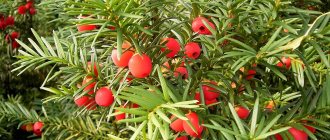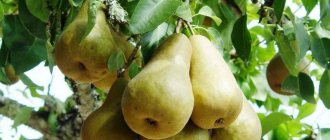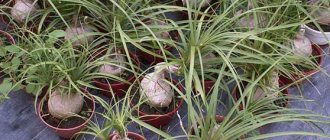- October 13, 2018
- Trees and shrubs
- Ksenia Yedikhanova
Avocados are known and loved by many, this is due to the unusual taste and high nutritional value of the fruit. Large green fruits can be purchased in almost any supermarket, but few people know how and where the avocado tree grows. Is it possible to grow an exotic crop yourself?
Appearance
What does an avocado tree look like? The plant is an evergreen tree that can reach a height of 6-18 m. The tree has ovate leaves with pointed tips, about 10-20 cm long and 2-12 cm wide, in a dark green hue. The flowers of the plant are unsightly, yellow-green in color, collected in small inflorescences in the form of umbrellas.
The avocado fruit is a green drupe with a thick, dark green skin. Its flesh is also green in color, has a slightly sweetish taste and a creamy-buttery consistency. The size of avocado fruits varies from 5 to 15 cm, depending on the degree of ripeness and variety.
The avocado tree can be of three varieties:
- West Indian - suitable for growing in tropical climates with high humidity.
- Guatemalan is a hardy species that grows in subtropical mountainous areas.
- Mexican is the most common variety due to its resistance to slight low temperatures, which other varieties cannot boast of.
Due to different varieties of culture, avocados from different countries may have slightly different appearance and taste.
Application of Persea americana
The exotic fruit is widely used in cooking in the preparation of salads and savory snacks. Guacamole (avocado puree) has become a national Mexican dish. Gourmets from other countries also enjoyed the exquisite dish. The pulp of the fruit is used in many nutrition programs because it contains virtually no sugar. The glycemic index of American persea is only 10 units, which diabetics should take note of.
The benefits of avocados for women are difficult to overestimate. The pulp of the fruit is used to create masks for dry hair because it is quite oily. Avocado for the face in the form of creams will help with the appearance of the first wrinkles.
Avocado is a plant whose leaves, seeds and wood are poisonous. If there are children and animals in the house, you need to make sure that they do not get poisoned by them. However, wood has a certain value: after special processing it is used as a building material.
Avocado is used in cooking for making salads and snacks
Purchase of planting material
You can try growing an avocado tree at home. To do this, you should take care of good planting material - a seed. It must be removed from ripe fruit purchased in a store. You need to choose the right avocado in order for the seed to germinate. For these purposes, only ripe fruits should be used. You can check ripeness in the following way: lightly squeeze the avocado with your palms, the fruit should take its previous shape after that. If you can’t buy ripe fruit, don’t despair, because it can always ripen at home on the windowsill.
After purchasing an avocado, the fruit itself can be eaten, because only the seed has value for germination. You need to remove it carefully so as not to damage its peel.
Photo
This section presents photographs of leaves, fruit, and trees that can easily be grown at home.
Planting methods
At home, an avocado tree can be grown in three ways:
- The seed is planted in loose soil with the blunt end down. It is important that the sharp end rises slightly above the surface of the ground. It is necessary to water the seedlings once every 7 days with clean water. This method is the simplest, but you will have to wait a long time for the first shoots, since the roots need to break through the hard crust of the seed.
- You need to punch three holes in the pit. After this, it is placed in water so that the holes are above the surface of the liquid. It remains in this state until germination, after which it can be placed in the ground.
- The last method involves completely clearing the seed from its shell. After this, it is placed in water until roots appear. This method is not only the fastest, but also the most interesting, since it becomes possible to observe the formation of the root system.
Regardless of the chosen method of planting an avocado seed, seedlings appear in 90% of cases, which is considered a fairly high figure.
Growing in the ground
After the avocado tree sprouts from the seed, you can begin planting it in the ground. It is recommended to use universal soil for indoor plants, as it has a sufficient amount of nutrients and a loose structure. The soil must be well drained so as not to retain excess moisture, which is detrimental to the roots.
Experienced gardeners suggest adhering to the following planting system:
- drainage must be at least 2 cm in height;
- the bone goes two-thirds into the ground with the blunt end down;
- in this case, the sharp end must remain above the surface of the earth;
- After planting, it is recommended to water the plant with warm water once a week.
To ensure good rooted growth, it is necessary to fertilize the plant once every 2 weeks. In addition, avocado is a light-loving crop, so you should take care of good lighting in the place where the pot is located.
How to care?
How does an avocado grow? Despite the fact that countries with very warm climates are considered its homeland, growing avocados from seeds at home is possible. To do this, you need to know some nuances about caring for wood.
The optimal temperature for the plant is considered to be about +23 degrees, while in winter these indicators can be reduced to +10 degrees. If the temperature is below this mark, it will be detrimental to the young plant.
Flowering begins in the third year of the tree's life. In order to subsequently obtain fruits, it is necessary to have several plants so that they can be pollinated by insects. At the same time, it is recommended to expose the tree outside to direct sunlight in the spring and summer, as this has a beneficial effect on its growth and provides an opportunity for natural pollination.
Watering should also change throughout the year:
- in spring and summer, watering is required as the soil dries;
- in winter, after the soil dries, at least 2 days must pass before the next watering.
It is recommended to use settled water at room temperature. In this case, it is necessary to add fertilizer for citrus crops to the water and fertilize it with this composition once every 2 weeks in the spring and summer.
From the moment of flowering to the formation of fruits, about 6 months pass; during this time it is important to carefully care for the plant in order to obtain high-quality fruits.
An interesting option is to plant three seeds in one pot and then weave the trunks into a braid. At the same time, it is not recommended to make it tight; you need to leave space to compact the stems.
Recipes
Persea americana is used as follows:
- Strengthening the immune system. For these purposes, prepare jam from avocado, dried apricots, figs and prunes, 1 tbsp each. l. each ingredient. Dried fruits soaked in water and crushed in a blender are mixed with softened avocado pulp. You can add honey to the jam. Store the mixture in the refrigerator and consume a teaspoon 3 times a day.
- Rejuvenating mask. Avocado for the face is a popular product because it does not form a film on the skin. The pulp of half an agacat is crushed with 1 tsp. olive or flaxseed oil. The mask is applied to the face-décolleté area and left on for 20 minutes. The mixture is washed off with warm water. Ready-made avocado oil from the pharmacy will also benefit women.
- Treatment of impotence. For men suffering from erectile dysfunction, a whole system of taking the fruit has been developed. For breakfast, fry 2 egg whites and mix them with alligator pear pulp. Season scrambled eggs with hot cayenne pepper and eat them in the morning for 2 weeks. A vitamin mixture is prepared for lunch and dinner. A medium-sized watermelon is cut into cubes, mixed with one avocado and 40 g of mint chopped in a blender. The drink is taken 2 times a day for 15 days.
Masks, jams and salads are made from avocados
Treatment of diseases
When growing an avocado tree at home, you should beware of the same diseases that affect many other cultivated plants:
- Phytophthora is a fungal disease that over time destroys the root system. The disease can be identified by the sudden appearance of ulcers on the trunk and leaves of the tree. After detection, the affected plant should be set aside from others and the affected parts should be pruned.
- Spider mites appear when there is high humidity in the room where the avocado grows. It can be identified by yellowing leaves and their falling off. The diseased plant must be sprayed with a soap solution and the affected parts of the tree removed.
- Powdery mildew appears as a white coating on the leaves, causing them to curl. This disease can be controlled with fungicides.
In addition, the avocado tree at home is susceptible to the same pests that affect other indoor plants. These are scale insects, whiteflies, aphids, and mealybugs.
Pest Control
- Insects . The yellow color and shedding of leaves can be caused not only by a violation of the temperature and watering regime, but also by parasitic infestation. Frequent culprits: spider mites or actively reproducing scale insects. They quickly lead a once healthy plant to death. Medicines containing avermecatins are effective against ticks. And wiping the leaves with a soap solution will help against scale insects.
- Fungi . In addition to powdery mildew, avocados are attacked by late blight. In this case, it will not be possible to cure the tree. The roots and bark are massively affected. Unfortunately, we have to get rid of the entire plant.
Tree pruning
Although the avocado tree does not grow to its maximum size at home, it is necessary to periodically prune it. This way you can control its length and give it the desired shape. Trees that are not pruned have a minimum number of side shoots, grow exclusively in height and, as a result, have an unattractive appearance.
To form a beautiful crown, which can be seen in any photo of an avocado tree, pruning in a pot must be done every spring. In the first year of growth, it is important to shorten the tree after 7-8 leaves, and the side shoots after 5-6. In the future, annual pruning can increase the number of side shoots and control the height of the tree.
Beneficial features
Despite the fact that growing a fruit-bearing avocado tree at home is quite difficult and time-consuming, the resulting fruit will undoubtedly delight you. In addition to the classic taste, they have the same beneficial properties as store-bought fruits:
- vitamins A and E;
- monosaturated fats;
- antioxidants;
- useful minerals.
Based on the totality of useful substances, avocado fruits are good in that they prevent diseases of the cardiovascular system, have a beneficial effect on the gastrointestinal tract, and are useful for diabetes and cataracts.
Despite its benefits, avocado, like most other fruits, is not hypoallergenic, so it can cause individual allergic reactions. For this reason, it is not recommended to give avocados to children under 14 years of age.
The benefits of avocado fruit
The second name for avocado is the name alligator pear. It is likely that it received its second name because of its similarity to a pear. Gardeners do not exclude the possibility that they previously had one common relative, but due to environmental or climatic changes in the region where they grew, the plants were transformed.
Nowadays, the avocado fruit is used not only for food, but also in cosmetology (for creating creams, scrubs and masks), in medicine (for treatment, as well as for the prevention of various diseases) and other industries.
In medicine, avocados are used to treat the digestive and circulatory systems. Avocado oil is used not only for medical, but also for cosmetic purposes.
Features of a home tree
A home-grown avocado has some differences from a naturally grown avocado:
- The height of a tree in nature can reach 18 m, while the height of a home avocado reaches a limit of 2 m. At the same time, it looks quite decorative and interesting.
- It takes a lot of time and effort to create the conditions in which a tree begins to bear fruit, so most often such a tree is used exclusively for decorative purposes.
- If all conditions are created for the plant to bear fruit, its fruits are slightly inferior in size and taste to the imported ones.
- Avocados purify the air, which is why they are popular among gardeners.
In general, growing an avocado does not present any particular difficulties if there is no goal to ensure its constant fruiting.











